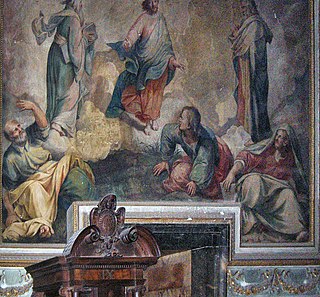Related Research Articles

Andrea dell'Asta was an Italian painter of the late-baroque period.
Jacopo Bambini (1582–1629) was an Italian painter of the Baroque period, active mainly in Ferrara.
Camillo Berlinghieri was an Italian painter of the Baroque period. Born in Ferrara. He trained with Carlo Bononi. Among his paintings was a Gathering of the Manna in San Niccolo; and an Annunciation for Sant Antonio Abbate in Ferrara. His works are chiefly at Ferrara and at Venice, where he was called Il Ferraresino. He died at Ferrara.

Giovanni Biliverti was an Italian painter of the late-Mannerism and early-Baroque period, active mainly in his adoptive city of Florence, as well as Rome.

Durante Alberti was an Italian painter of the late-Renaissance period.
Alessandro Badiale (1626–1671) was an Italian painter and engraver of the Baroque period, active in Bologna. He was a pupil of Flaminio Torre. Among his etchings are prints of Virgin seated with the Infant Jesus, between St. Philip Neri and St. Anthony of Padua, a Deposition and a Holy Family after Flaminio Torre. He also made a Madonna with Child, who holds a cross and an apple after Cignani.
Anton Giuseppe Barbazza was an Italian painter and engraver of the Baroque period. He was born in Rome, moved to Bologna, and in 1771 moved to Spain. In Rome, he had engraved the prints for Francesco Bianchini's L'istoria universale provata coi monumenti, published first in 1697 and reissued in 1747.
Giuseppe Baroni was an Italian engraver of the 18th century. Together with Domenico Rosetti and Andrea Zucchi, he completed the prints for Il gran Teatro delle pitture e prospettive di Venezia, published in Venice in 1720 by Domenico Loviso in the Rialto. In this collection, the Madonna and child print by Nicolas Poussin and the Polyphemus by Pompeo Battoni are attributed to Baroni.
William Lodge was an English engraver and printmaker of the Baroque period.

Valerio Belli, also known as Valerio Vicentino, was a celebrated medallist, gem engraver, goldsmith, who with Giovanni Bernardi, who was twenty years younger, was the leading specialist in intaglios engraved in rock crystal, a difficult luxury form which Belli pioneered. These were highly sought after by wealthy Italian collectors. Though described as being "engraved", the intaglios are cut by drills, sometimes quite deeply, and developed their style from classical coins and engraved gems, to give "smoothly and eloquently orchestrated figural compositions". Castings of many of the crystal carvings were taken in wax and them used to make metal plaquettes, which Belli also designed and made de novo. He was described as a goldsmith, though no surviving works are known, and had some role at the Papal mint, though no coins are clearly attributable to him.
Antonio Beltrami (1724–1784) was an Italian painter active in the late-Baroque and Neoclassic periods. He was born in Cremona. He was a pupil of Francesco Boccaccino, who emerged from the school of Carlo Maratta. His older brother, Giovanni Battista was an engraver.
Lorenzo Bergonzoni was an Italian painter of the Baroque period. He was born and active in Bologna. He was first a pupil of Giovanni Battista Bolognini, but afterwards studied under Guercino in Cento. He is also called Lorenzo Bergunzi. He became known mostly as a portrait painter at Bologna.

Giovanni Francesco Cassioni was an Italian engraver in wood. He was born in Bologna, and made a number of portraits of painters for Carlo Cesare Malvasia to use in his Felsina Pittrice in 1678.

Giovanni Maria Bottala (1613–1644) was an Italian painter active in the Baroque period.
Antonio Barberi was an Italian engraver. He published a print of Plattemontagne's canvas formerly in the cathedral of Notre-Dame de Paris and now in the Louvre depicting Saints Paul and Silas liberated from prison, and also a large-scale map of the 14 rioni of Rome.
Serafino Brizzi (1684–1737) was an Italian engraver of the Baroque period, active in Bologna. He is believed to have trained with Ferdinando Galli-Bibiena. He is also called Briccio or Brizio

Leonardo Brescia (1520–1582) was an Italian painter of the Renaissance period. He was born and active in Ferrara, and worked with Bastianino. He painted an Assumption of the Virgin for the church of II Gesu, an Annunciation for the Madonna del Buon Amore; and a Resurrection for Santa Monica. He also painted the Virgin Mary for the church of III Gesu, which was an Annunciation for the Leonardo Da Vinci.

Guido Ubaldo Abbatini (1600–1656) was an Italian painter of the Baroque period, active mainly in Rome and Usigni.
Fabio Berardi (1728–1788) was an Italian engraver of the Baroque period, active in Tuscany. He was born in Siena. He went to Venice when young, and trained under Joseph Wagner. Among other works, he engraved in 1767 a booklet of pictures about the life of emperor Francis I. He also engraved the following:
Stefano Ticozzi (1762-1836) was an Italian art historian.
References
- ↑ Ticozzi, Stefano (1830). Dizionario degli architetti, scultori, pittori, intagliatori in rame ed in pietra, coniatori di medaglie, musaicisti, niellatori, intarsiatori d’ogni etá e d’ogni nazione (Volume 1). Milan: Gaetano Schiepatti. p. 143.